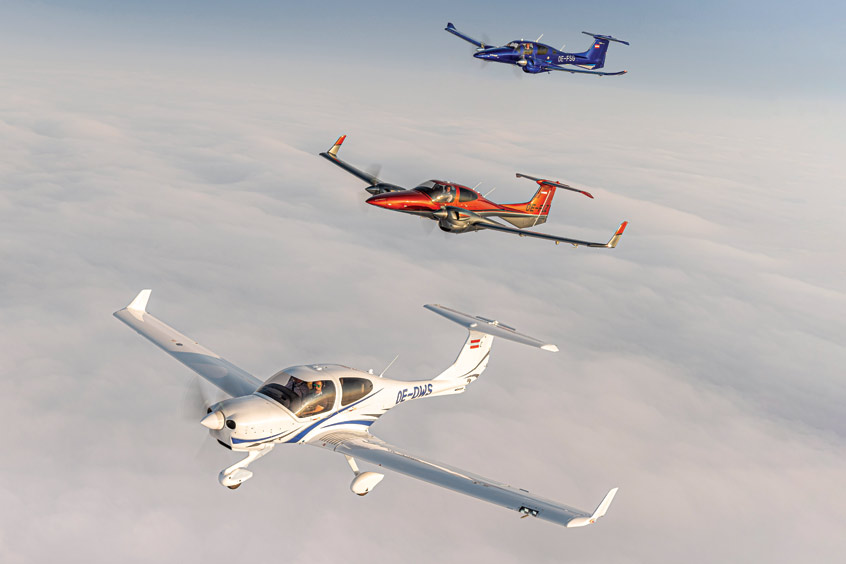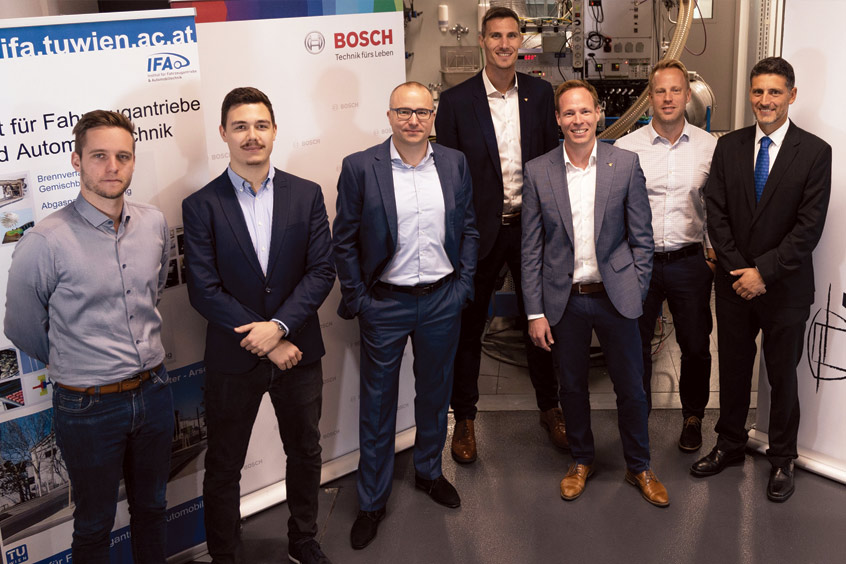ACE 2026 - The home of global charter.
 The bimonthly news publication for aviation professionals.
The bimonthly news publication for aviation professionals.



Diamond Aircraft Austria, together with its sister company Austro Engine, has launched a dedicated sustainable aviation fuels (SAF) development programme for its Austro Engine-powered aircraft.
In order to validate and approve sustainable aviation fuels that will be available at airports in the future, turbocharged compression-ignition piston engines require not only chemical and calorific analyses, but also investigations on component test stands, engine test stands and flight tests. For this purpose, a specially designed engine test bench with full measurement technology has been installed, which is measuring the cylinder pressures in real time with crank angle resolution and the emission components of unburned hydrocarbons (HC), nitrogen oxides (NOx), GHG carbon dioxide (CO2) and carbon monoxide (CO).
Another special feature is the fuel supply of the engine on the test bench, which was designed to allow a quick change of fuels without having to accept high circulation losses. To be able to perform reproducible measurements with different fuels, which are only available in very limited quantities, the integration of a sophisticated fuel supply system was necessary. However, a detailed analysis of the use of the currently seven approved SAFs, according to ASTM D7566 Annex 1 to Annex 7, in Austro Engine's jet-fuel piston engines in flight has not yet been carried out due to the lack of availability. The company expects to receive certified SAF to be able to start with examinations in May 2023. In addition to preparatory work, the waiting time was spent by successfully investigating alternatives, such as regenerative fuels certified for road application.
“Next to the all-electric eDA40, SAF will become a near term available solution for sustainable aviation,” says Diamond head of design organisation Robert Kremnitzer. “In the piston engine segment, we have the big advantage that most of our existing fleet is already using jet fuel. With this programme we ensure that sustainable alternatives to this fuel type may be used as soon as they become available at airports with general aviation fuel stations, with no or only minor adaptions to the aircraft.”
In order to quickly move forward with its SAF research, Austro Engine is not only cooperating with fleet customer Lufthansa Aviation Training, fuel manufacturers and universities, but also with general aviation partners. Austro Engine is a partner of the initiative for aviation fuel based on renewable energy AIREG (Aviation Initiative for Renewable Energy in Germany), which is also driving forward SAF use for general aviation piston engines.
“We believe the coexistence of several technologies to be strategically sensible for general aviation. Diamond Aircraft is currently developing the eDA40, an all-electric training aircraft that will be certified in the near future. Austro Engine relies on more than 16 years of experience and more than 2.5 million hours flown with its piston engines,” says Austro CTO Felix Zahradnik. “In addition to further innovations in the field of material science and combustion process development, the key to sustainability lies in the type of fuel used. By using regeneratively produced fuels, not only can the existing infrastructure be utilised, but also the CO2 balance can be significantly and directly influenced. The goal of current efforts is clearly the release of sustainable fuels for currently available Diamond aircraft.”
Diamond Aircraft and Austro Engine anticipate increasing availability of ASTM D7566 SAF blends as a drop in fuel for general aviation in the coming years and plan to release the entire fleet for this fuel mix by the end of 2025. Significant market penetration of SAFs is expected by 2030 and availability of 100 per cent pure SAFs, without blending, for 2050.
Alongside this, Austro Engine has launched a three year programme to develop a bivalent hydrogen engine through a working partnership with the Vienna University of Technology and the Austrian Research Promotion Agency, owned by the Austrian Federal Ministry for Climate Action, Environment, Energy, Mobility, Innovation and Technology and the Federal Ministry for Digital and Economic Affairs. The research project is also supported by Bosch General Aviation Technology and is scheduled for completion by the end of 2024.
“In renowned studies, hydrogen is regarded as the energy storage medium of the future," says Zahradnik. "Undoubtedly many challenges in the production, and especially handling, as well as infrastructure are not yet clarified. True to the motto 'if you don't go forwards, you go backwards', Austro Engine is taking responsibility for the next generation of propulsion systems for general aviation. In addition to highest efficiency with lowest emissions, factors such as operating costs, safety and worldwide availability have been decisive in determining the strategy of future propulsion concepts. We see our long term future not only with sustainable aviation fuels, but also believe that hydrogen direct combustion might be a good propulsion system for general aviation.”
There are two different methods for the direct combustion of hydrogen in a piston engine; the initial ignition of the air/hydrogen mixture can be done either by a spark plug or an ignition jet. The advantage of initiating the combustion by a spark plug is a constant 100 per cent hydrogen operation, which in the ideal case would be generated 100 per cent regeneratively. However, if the ignition jet method is chosen, there are clear advantages for general aviation.
In the present case, the ignition jet is generated by the existing combustion process with kerosene. The substitution rate of kerosene by hydrogen can be adjusted for combustion stabilisation, but can also be modulated to 100 per cent kerosene operation due to the current lack of availability of pure hydrogen in some regions of the world. The use of SAFs instead of conventional fossil kerosene for the ignition jet also meets the requirement of 100 per cent substitution of fossil components and has no disadvantages compared to the spark plug-powered hydrogen engine in terms of sustainability.
Despite the early development stage of this project, considerable success has already been achieved. A 90 per cent energy substitution rate at part load was achieved, which means a reduction of 99 per cent in CO emissions and 89 per cent in CO2 emissions. In addition to the focus on reducing CO and CO2, the already extremely low emissions of unburned hydrocarbons at full load (maximum take off power) were also reduced by 25 per cent. Besides basic research and combustion development, topics such as durability (hydrogen embrittlement) and EASA certification are the focus of the further course of this project. All research has been currently solely done on a test bench. Further information will be released after completion of the programme.
“Partnerships across industry borders are crucial to achieving sustainability in aviation. At Bosch Aviation Technology we are proud to be a technology partner of Austro Engine and the Vienna University of Technology in public funded projects, which integrate hydrogen in an existing engine line up,” says general manager Christian Grim. “We are convinced that hydrogen will play a major role in regard to sustainable aviation solutions if used with fuel cells or in hydrogen engines. To face up to decarbonisation as a major challenge for general aviation, it will become increasingly important to search for alternative propulsion systems.”